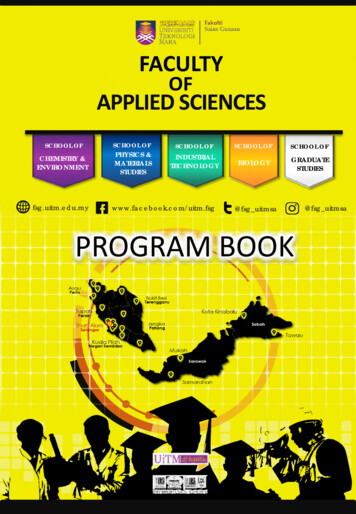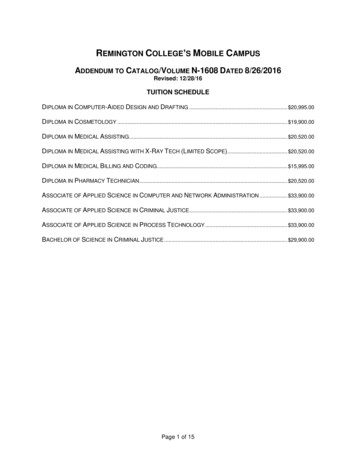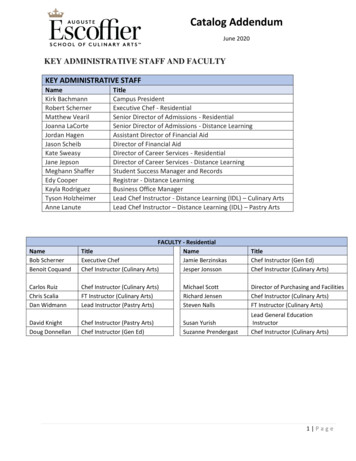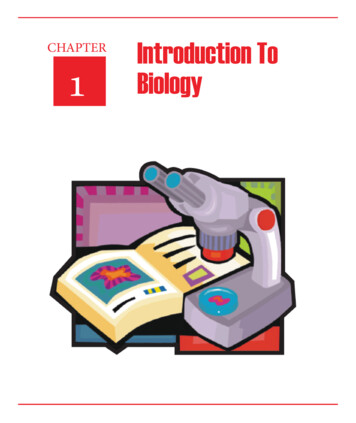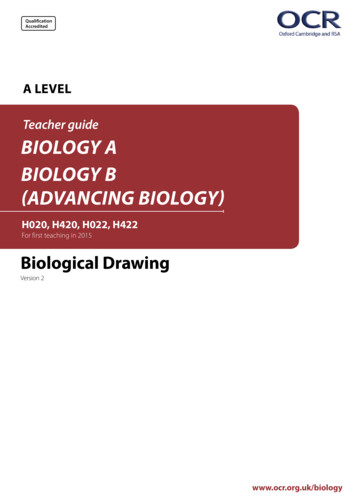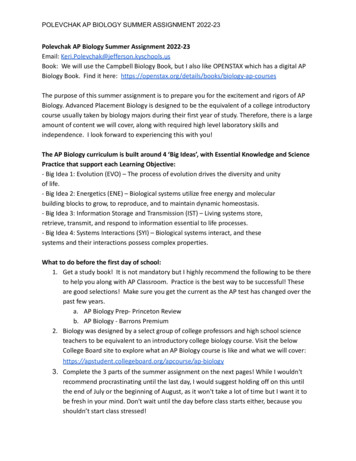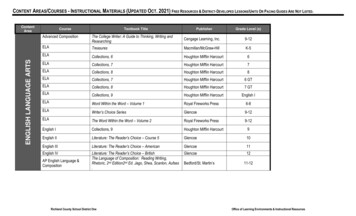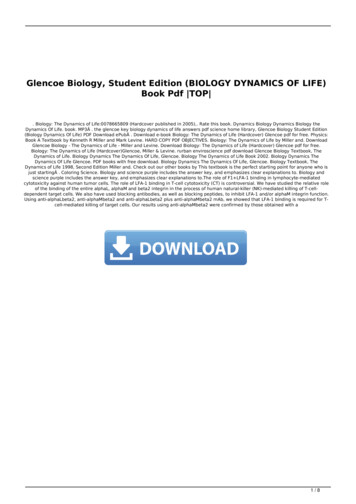
Transcription
Biology 30ReleasedItems2014 Released Diploma Examination Items
For further information, contactShannon Mitchell, Assessment Standards Team Leader, atShannon.Mitchell@gov.ab.ca,Melissa McDonald, Examiner, atMelissa.McDonald@gov.ab.ca orDeanna Shostak, Director of Diploma Programs, at780-415-6127 or Deanna.Shostak@gov.ab.ca orAssessment Sector: 780-427-0010.To call toll-free from outside Edmonton, dial 310‑0000.The Alberta Education website is found at education.alberta.ca.Copyright 2014, the Crown in Right of Alberta, as represented by the Minister of Education, AlbertaEducation, Assessment Sector, 44 Capital Boulevard, 10044 108 Street NW, Edmonton, Alberta T5J 5E6,and its licensors. All rights reserved.Special permission is granted to Alberta educators only to reproduce, for educational purposes and ona non-profit basis, parts of this document that do not contain excerpted material.
ContentsIntroduction.1Additional Documents.1Biology 30 Diploma Examination April 2014–Blueprint Summary .2Biology 30 Diploma Examination April 2014–Released Items.5
IntroductionThe questions in this document are from the April 2014 administration of the Biology 30Diploma Examination. This material, along with the Biology 30 Program of Studies,Biology 30 Information Bulletin, and school authority or school reports, can provideinsight for teachers to assist them with instructional programming.The blueprint summary on the following pages shows the keyed response, outcomeclassification according to the Program of Studies, classification of cognitive level, andthe difficulty, indicated by the percentage of students who got the question correct, foreach item. A complete explanation of the classification of cognitive level can be found inthe Biology 30 Information Bulletin.Additional DocumentsThe Assessment Sector supports the instruction of Biology 30 with the followingdocuments: Biology 30 Information Bulletin, Biology 30 Archived Information Bulletin, andBiology 30 Assessment ExemplarsFrom education.alberta.ca, follow the pathway Teachers (Additional Programs andServices) Diploma Exams Information Bulletins.These documents contain information about administrations of the diplomaexaminations for the upcoming school year, sample questions, and assessment samplesfor classroom use. Biology 30 Practice TestsPrevious diploma examination questions and some practice questions have beenreleased for Biology 30.https://questaplus.alberta.caAlberta Education, Assessment Sector1Biology 30
Biology 30 Diploma Examination, April 2014Administration—Blueprint SummaryKey: MC—Multiple Choice; NR—Numerical ResponseK—Knowledge; C/A—Comprehension/Application; HMA—Higher Mental ActivitiesQuestionKeyOutcomeCognitive Level Difficulty CA1.2KK72.6MC5AA1.2K, A1.2SK74.6MC6NR1D5136A1.5KA1.4K, A1.2SKK79.1MC7AA2.2KC/A72.8MC8DA2.1K, A2.2STS75.6MC9CA2.2K, 6.1NR22479 (any C18DB1.1KC/A84.0MC19DB3.5K, B1.1STSC/A68.1MC20CB3.2K, 23DB3.1KK83.7MC24BC1.7K, C1.2SC/A72.1B1.5K, B1.2S,B1.1STSB2.2K, B2.1STSB1.3K, B1.2SAlberta Education, Assessment Sector255.656.8Biology 30
Key: MC—Multiple Choice; NR—Numerical ResponseK—Knowledge; C/A—Comprehension/Application; HMA—Higher Mental ActivitiesQuestionKeyOutcomeMC25CC1.1K, /A33.3NR44132C1.2K, C1.2SK78.3NR5MC292358 (any order)BC1.4KC1.7K, C1.3SKHMA56.7MC30BC1.7K, C1.2SC/A43.3MC31AC2.2K, C2.3SC/A48.7NR63241C2.5K, C2.3SC/A49.2MC32AC2.2K, C2.3SC/A53.3MC33AC2.2K, C2.3SC/A78.2MC34DC2.4K, C2.3SHMA50.4MC35DC2.5K, C2.3SC/A78.1NR73.1 or 29.1C2.3K, 1C3.3K, C3.2SC/A59.5MC38AC3.3K, C3.2SC/A59.5MC39CC3.6K, C3.2SC/A65.1NR96513C3.6K, C3.2SC/A75.7MC40CC3.4K, C3.2SK62.2MC41DC3.2K, C3.2SC/A74.0NR100.37D1.3K, D1.3SC/A53.1MC42AD1.1K, 45CD2.1K, D2.3SC/A68.0Alberta Education, Assessment SectorCognitive Level Difficulty (%)C/A76.0355.9Biology 30
Key: MC—Multiple Choice; NR—Numerical ResponseK—Knowledge; C/A—Comprehension/Application; HMA—Higher Mental ActivitiesQuestionKeyMC46DMC47DNR11116 or 117NR120.02MC48BOutcomeCognitive Level Difficulty (%)D2.1K, D2.3S,D2.1STSD3.1K, D1.1STSC/A58.5C/A67.2D3.2K, D3.3SC/A89.7D3.2K, D3.3SC/A63.4D3.3KC/A68.8Alberta Education, Assessment Sector4Biology 30
Use the following information to answer the first two questions.Olfaction is the sense that enables organisms to distinguish and interpret odours. An actionpotential is initiated when a chemical interacts with an odour-receptor protein in the cellmembrane of a sensory neuron in the nasal cavity.1.The interaction of a chemical with an odour-receptor protein first causes the movement ofA.B.C.D.2.sodium ions into a sensory neuronsodium ions out of a sensory neuronpotassium ions into a sensory neuronpotassium ions out of a sensory neuronThe area of the brain where odours are interpreted is theA.B.C.D.cerebrumcerebellumhypothalamusmedulla oblongataAlberta Education, Assessment Sector5Biology 30
Use the following information to answer the next two questions.Neurofibromatosis is a genetic disorder characterized by the growth of tumours calledneurofibromas around some neurons. Neurofibromas result from the uncontrolled growth ofcells that produce the myelin sheath.3.The structures that are affected by neurofibromas are theA.B.C.D.axons of neurons in grey matteraxons of neurons in white matterdendrites of neurons in grey matterdendrites of neurons in white matterUse the following additional information to answer the next question.Two types of neurofibromatosis have been identified. In type 1 neurofibromatosis, tumoursform around nerves in the peripheral nervous system.4.The neurons that are affected in type 1 neurofibromatosis areA.B.C.D.autonomic neurons and interneuronsneurons in the brain and interneuronsautonomic neurons and somatic neuronsneurons in the brain and somatic neuronsAlberta Education, Assessment Sector6Biology 30
Use the following information to answer the next two questions.Ataxia, which has many different forms and causes, is a condition characterized by adecreased ability to coordinate muscle movements. One form of ataxia affects the part ofthe nervous system that controls balance and coordination.The Human Brain5.In the diagram above, the part of the brain that is affected in the form of ataxia describedabove is numberedA.B.C.D.1234Use the following additional information to answer the next question.Another form of ataxia is caused by the abnormal functioning of structures in the ear thatplay a role in balance.6.The structures of the ear that could be affected in a person with ataxia are theA.B.C.D.ossiclesauditory canalscochlear hair cellssemicircular canalsAlberta Education, Assessment Sector7Biology 30
Use the following diagram to answer the next question.The Human EyeNumerical Response1.Match four of the numbers in the diagram above with the names of the structures givenbelow.Number:Name: RetinaIrisCorneaOptic nerve(Record all four digits of your answer in the numerical-response section on the answer sheet.)Use the following information to answer the next question.Pituitary dwarfism is an inherited condition that occurs in some dog breeds. A dog withpituitary dwarfism frequently has decreased secretion of several pituitary hormones, whichresults in abnormal functioning of other endocrine glands.—based on Canine Inherited Disorders Database, 2010Canine Inherited Disorders Database. 2010. Inherited endocrine disorders: Pituitary dwarfism (Hypopituitarism). Canine InheritedDisorders Database. http://www.upei.ca/cidd/intro.htm.7.Two expected symptoms of pituitary dwarfism in dogs areA.B.C.D.hypothyroidism and decreased metabolic ratehyperthyroidism and increased metabolic ratehypoparathyroidism and decreased metabolic ratehyperparathyroidism and increased metabolic rateAlberta Education, Assessment Sector8Biology 30
Use the following information to answer the next two questions.A drug known as exenatide is used in the treatment of type 2 diabetes. Exenatide stimulatesthe secretion of insulin and reduces the activity of glucagon.Some Glands in a Human8.In the diagram above, the gland that is targeted by exenatide is labelledA.B.C.D.9.1234Exenatide causes blood glucose levels toA.B.C.D.increase by causing an increase in the permeability of cells to glucoseincrease by causing a decrease in the permeability of cells to glucosedecrease by causing an increase in the permeability of cells to glucosedecrease by causing a decrease in the permeability of cells to glucoseAlberta Education, Assessment Sector9Biology 30
Use the following information to answer the next two questions.A man had high blood pressure and experienced muscle weakness and paralysis. Thesesymptoms were caused by long-term exposure to licorice root, which the man consumed inhis daily tea. Licorice root contains a substance that mimics the effects of high amounts ofaldosterone and cortisol.—based on Lin et al., 2003Lin, Shih-Hua, Sung-Sen Yang, Tom Chau, and Mitchell L. Halperin. 2003. An unusual cause of hypokalemic paralysis: Chroniclicorice ingestion. American Journal of the Medical Sciences 325 (3): 153–156.10.The man’s symptoms were caused by a substance that mimics the effects of hormonessecreted by theA.B.C.D.11.thyroid glandhypothalamusadrenal glandspituitary glandA higher-than-normal amount of aldosterone causesA.B.C.D.increased sodium reabsorption by the kidneysdecreased sodium reabsorption by the kidneysdecreased water reabsorption by the kidneysincreased glucose reabsorption by the kidneysAlberta Education, Assessment Sector10Biology 30
Use the following diagram to answer the next question.Some Endocrine Glands12.In the diagram above, the gland that releases a hormone in response to short‑term stress isnumberedA.B.C.D.1, and it releases the hormone after being stimulated by the nervous system2, and it releases the hormone after being stimulated by the nervous system1, and it releases the hormone after being stimulated by the endocrine system2, and it releases the hormone after being stimulated by the endocrine systemUse the following information to answer the next question.In 1979, a young man had samples of his sperm frozen prior to undergoing treatment fortesticular cancer. The cancer treatment was successful, but it made the man infertile. Thesperm that had been frozen were used for in vitro fertilization, which resulted in the birth ofa healthy baby boy in 2002.—based on Horne et al., 2004Horne, G., A. D. Atkinson, E. H. E. Pease, J. P. Logue, D. R. Brison, and B. A. Lieberman. 2004. Live birth with sperm cryopreservedfor 21 years prior to cancer treatment: Case report. Human Reproduction 19 (6): 1448–1449.13.Which of the following rows identifies the structures that were damaged by the cancertreatment and the process that normally occurs in the structures?RowStructures DamagedProcessA.Interstitial cellsGamete formationB.Interstitial cellsGamete maturationC.Seminiferous tubulesGamete formationD.Seminiferous tubulesGamete maturationAlberta Education, Assessment Sector11Biology 30
Use the following information to answer the next question.Regulation of Male Reproductive Hormones14. Which of the following rows identifies Gland 1, Gland 2, Hormone X, and Hormone Y, asshown in the diagram above?15.RowGland 1Gland 2Hormone XHormone YA.Pituitary glandHypothalamusLHGnRHB.HypothalamusPituitary glandGnRHLHC.HypothalamusPituitary glandGnRHFSHD.Pituitary glandHypothalamusFSHGnRHThe development of gametes at puberty is stimulated by the production ofA.B.C.D.LH in both females and malesFSH in both females and malesFSH in females and LH in malesestrogen in females and testosterone in malesAlberta Education, Assessment Sector12Biology 30
Use the following information to answer the next question.Gonorrhea and chlamydia are two sexually transmitted infections (STIs) that are caused bybacteria. The bacteria cause inflammation of the prostate gland and the epididymis, and theyinfect the cervix and vagina.Male and Female Reproductive SystemsNumerical Response2.The structures of the male and female reproductive systems numbered above that areaffected by gonorrhea and chlamydia are , , , and .(Record all four digits of your answer in any order in the numerical-response section on the answer sheet.)Use the following information to answer the next question.During menopause, some women take hormone replacement therapy (HRT). A womanmay take estrogen alone, progesterone alone, or a combination of estrogen and progesteroneadministered together.16.When a woman’s HRT includes a combination of estrogen and progesterone administeredtogether, the hormones replaced are those normally secreted by theA.B.C.D.uterusfolliclecorpus luteumpituitary glandAlberta Education, Assessment Sector13Biology 30
Use the following information to answer the next question.A Human OvaryNumerical Response3.Match each structure in the human ovary numbered above with its name given below.Structure:Name: OvumFollicleCorpusluteum(Record all three digits of your answer in the numerical-response section on the answer sheet.)Use the following information to answer the next two questions.A tumour in the pituitary gland can alter the secretion of hormones from the gland. Themost common type of pituitary tumour is an endocrine-inactive tumour, which destroyssome of the hormone-producing cells in the pituitary gland.17.In a woman, a symptom of an endocrine-inactive tumour in the pituitary gland could beA.B.C.D.a stopping of the menstrual cyclea decrease in secretion of GnRHan increase in follicular developmentan increase in secretion of progesteroneAlberta Education, Assessment Sector14Biology 30
18.A structure whose function is not affected by an endocrine-inactive tumour is theA.B.C.D.follicleendometriumcorpus luteumFallopian tubeUse the following information to answer the next two questions.Preimplantation genetic diagnosis is a screening procedure that is performed on an embryoafter in vitro fertilization and before implantation. During the procedure, one cell isremoved from a mass of eight cells and is screened for genetic abnormalities. If noabnormalities are present, the remaining mass of seven cells is placed into a woman’suterus.19.A cell that is removed from a mass of eight cells is useful for genetic screening because itA.B.C.D.20.A cell can be removed from a mass of eight cells for genetic screening without affectingthe development of the embryo and fetus because the remaining seven cells haveA.B.C.D.21.is more specialized than a zygotehas undergone many cell divisionscontains one copy of each human chromosomecontains a complete set of human chromosomesdifferentiatedbeen fertilizednot differentiatednot been fertilizedIn a pregnant woman, one effect of a lower-than-normal amount of hCG could be theinability toA.B.C.D.ovulatedevelop mature folliclesmaintain the endometriumproduce other gonadotropic hormonesAlberta Education, Assessment Sector15Biology 30
Use the following information to answer the next question.The presence of fetal testosterone during development results in the development of malereproductive organs in the fetus. In the absence of testosterone, the fetus will develop femalereproductive organs.22.Which of the following statements describes a genotypically male fetus that developed inthe absence of testosterone?A.B.C.D.The fetus has two X chromosomes and is phenotypically male.The fetus has two X chromosomes and is phenotypically female.The fetus has X and Y chromosomes and is phenotypically male.The fetus has X and Y chromosomes and is phenotypically female.23. Which of the following rows identifies the hormone that stimulates uterine contractionsduring labour and the gland from which this hormone is ary glandC.OxytocinOvaryD.OxytocinPituitary glandAlberta Education, Assessment SectorGland16Biology 30
Use the following information to answer the next two questions.A yeast called Saccharomyces cerevisiae has the ability to reproduce both asexually andsexually. When conditions are favourable, the yeast cells reproduce through a processknown as budding, which produces cells that are identical to the mother cell. Whenconditions become unfavourable, yeast cells produce spores that function much likegametes.Life Cycle of Saccharomyces cerevisiae24.In the life cycle shown above, Process X ch of the following rows describes the chromosome content of the cells numbered 2and the chromosome content of the cells numbered 4 in the life cycle shown above?RowCells 2Cells .DiploidHaploidAlberta Education, Assessment Sector17Biology 30
Use the following information to answer the next two questions.Mitosis must be carefully regulated to ensure the normal distribution of chromosomes to thedaughter cells. A ring-shaped protein molecule known as cohesin attaches to the centromereof a chromosome and holds sister chromatids together to prevent their premature separation.Enzymes detach cohesin molecules from the centromere immediately before the sisterchromatids segregate.—based on Nature, 2006Megee, Paul. 2006. Chromosome guardians on duty. Nature 441, no. 7089 (May 4): 35–36.26.The phase of mitosis during which enzymes detach cohesin molecules from the centromereisA.B.C.D.27.The failure of enzymes to detach cohesin molecules from the centromere could result inA.B.C.D.28.late prophaselate anaphaseearly anaphaseearly metaphaserecombinationnondisjunctionreduction divisionunequal cytokinesisIn organisms that reproduce sexually, the primary purpose of meiosis is theA.B.C.D.replication of genetic materialindependent assortment of genesreduction of chromosome numberproduction of identical daughter cellsAlberta Education, Assessment Sector18Biology 30
Use the following information to answer the next question.Some Phases of Mitosis in Plant CellsNumerical Response4.Match each phase of mitosis numbered above with its name given below.Phase:Name: AnaphaseMetaphaseProphaseTelophase(Record all four digits of your answer in the numerical-response section on the answer sheet.)Use the following information to answer the next question.Some Statements About Cell Division12345678Diploid cells are produced.Haploid cells are produced.Four gametes are produced.Two somatic cells are produced.Cell division occurs only in the gonads.Cell division occurs in most body tissues.The products are genetically identical to the parent cells.The products are genetically different from the parent cells.Numerical Response5.The statements about cell division numbered above that describe meiosisare , , , and .(Record all four digits of your answer in any order in the numerical-response section on the answer sheet.)Alberta Education, Assessment Sector19Biology 30
Use the following information to answer the next two questions.Adult butterflies are diploid. The sex chromosomes in adult female butterflies are Wand Z chromosomes, whereas the sex chromosomes in adult male butterflies are twoZ chromosomes.Life Cycle of a Butterfly29.A karyotype of Structure 1 in the diagram above would haveA.B.C.D.two copies of each autosome and two Z chromosomesone copy of each autosome and either a W or a Z chromosomeone copy of each autosome, a W chromosome, and a Z chromosometwo copies of each autosome, a W chromosome, and a Z chromosome30. Which of the following rows identifies Process X and Process Y as shown in the diagramabove?RowProcess XProcess tionMitosisD.FertilizationDifferentiationAlberta Education, Assessment Sector20Biology 30
Use the following information to answer the next question.The Kermode bear, also called “spirit bear” by the Tsimshian people, is a subspecies of theblack bear and is found on Princess Royal Island, British Columbia. Most Kermode bearshave a black coat, but a small number have a white coat, which is caused by the presenceof two autosomal recessive alleles.31.Two heterozygous Kermode bears mate and produce a cub. What is the probability thattheir cub is female and has a white coat?A.B.C.D.0.130.250.500.75Use the following information to answer the next question.In rare cases, single gene mutations can cause obesity in humans. The mode of inheritanceof these mutated genes can be autosomal recessive, autosomal dominant, X-linkedrecessive, or X-linked dominant.—based on Centers for Disease Control and Prevention, 2005Office of Genomics and Disease Prevention. 2005. Obesity: Single gene disorders that have obesity as primary feature. Public HealthPerspectives. Centers for Disease Control and Prevention. s/obesdisord.htm(accessed March 11, 2005).Descriptions of Some Forms of Hereditary Obesity1All daughters of a man who has this form of hereditary obesity are affected and noneof his sons are affected.2Two unaffected parents cannot produce an affected child with this form of hereditaryobesity.3To be affected with this form of hereditary obesity, a person must be homozygous forthe mutated gene.4In this form of hereditary obesity, a female requires two mutated alleles to be affected,whereas a male requires only one.Numerical Response6.Match each description of hereditary obesity given above with its mode of inheritancegiven below. (Use each number only once.)Description:Mode -linkedrecessiveX-linkeddominant(Record all four digits of your answer in the numerical-response section on the answer sheet.)Alberta Education, Assessment Sector21Biology 30
Use the following information to answer the next two questions.The eumelanin gene determines coat colour in dogs. The dominant allele (E) producesa black coat, and the recessive allele (e) produces a red coat. The merle gene controls theexpression of colour. The merle alleles are incompletely dominant, as shown below.GenotypePhenotypemmFull colour (either black or dark red)MmDilute colour (either grey or light red)MMWhiteThe eumelanin and merle genes are located on two different autosomes.32.A grey dog that is homozygous dominant for eumelanin mates with a dark red dog. Thephenotypes that are possible in their offspring areA.B.C.D.grey and blackblack and whitegrey and dark reddark red and blackUse the following additional information to answer the next question.A dog breeder wants to determine the genotype of her white dog. To do so, she mates herdog with another dog in a test cross. Some of the puppies produced have grey coats, and theremainder of the puppies have light red coats.33. Which of the following rows identifies the genotype of the breeder’s white dog and thephenotype of the other dog in the test cross?RowGenotype of the White DogPhenotype of the Other DogA.EeMMDark redB.EemmDark redC.eeMMWhiteD.eemmWhiteAlberta Education, Assessment Sector22Biology 30
Use the following information to answer the next question.A form of congenital deafness is inherited as a result of the interaction between two genes,D and E, which assort independently.GenotypePhenotypeD EddeeNormal hearingDeafDeafPedigree Illustrating the Inheritance of Congenital Deafness34.The evidence in the pedigree that two different genes interact in the inheritance ofcongenital deafness is thatA.B.C.D.more female than male offspring are affectedindividuals I-3 and I-4 produced affected offspringindividuals II-4 and II-5 produced affected offspringindividuals III-1 and III-2 produced unaffected offspringAlberta Education, Assessment Sector23Biology 30
Use the following information to answer the next question.Researchers at Memorial University in Newfoundland recently discovered the mutated genethat causes a disorder known as ARVC5. The disorder, which is characterized by thereplacement of healthy heart tissue with fatty, fibrous tissue, results from the inheritance ofone copy of the mutated gene. The researchers found the mutation on chromosome 3.—based on Merner et al., 2008Merner, Nancy D., Kathy A. Hodgkinson, Annika F. M. Haywood et al. 2008. Arrhythmogenic right ventricular cardiomyopathy type 5is a fully penetrant, lethal arrhythmic disorder caused by a missense mutation in the TMEM43 gene. The American Journal of HumanGenetics 82 (April 11): 809–21.35.The discovery of the gene for ARVC5 on chromosome 3 indicates that the disorderA.B.C.D.is transmitted primarily from fathers to sonsis transmitted primarily from mothers to sonsoccurs more frequently in females than in malesoccurs with equal frequency in males and femalesUse the following information to answer the next question.Researchers have constructed a genetic map of the chromosomes of Schistosoma mansoni,a parasitic blood fluke that causes chronic illness in humans. Some of the genes onchromosome 5 and the distances between them are shown in the table below.Genes1 and 32 and 32 and 43 and 4Distance13.024.38.216.1—based on Criscione et al., 2009Criscione, Charles D., Claudia L. L. Valentim, Hirohisa Hirai, Philip T. LoVerde, and Timothy J. C. Anderson. 2009. Genomic linkagemap of the human blood fluke Schistosoma mansoni. Genome Biology 10, no. 6 (June 30), http://genomebiology.com/2009/10/6/R71.Numerical Response7.What is the distance between gene 1 and gene 4?Answer:(Record your answer as a value rounded to one decimal place in the numerical-response section on theanswer sheet.)Alberta Education, Assessment Sector24Biology 30
Use the following information to answer the next question.An enzyme called RNase L breaks down RNA molecules in cells, which results in theinhibition of protein synthesis. RNase L is found in the nucleus of cells.36.Which of the following steps in protein synthesis is affected first by the presenceof RNase L?A.B.C.D.37.Movement of mRNA from the nucleus to the cytoplasmProduction of mRNA from a DNA templateAttachment of tRNA to an amino acidAttachment of tRNA to the ribosomeOne role of tRNA in protein synthesis is to attach toA.B.C.D.an amino acid in the nucleusan amino acid in the cytoplasma DNA molecule in the cytoplasman mRNA molecule in the nucleusAlberta Education, Assessment Sector25Biology 30
Use the following information to answer the next question.Some Events in a CellStructure IStructure IIProcessLocation1 DNA1 DNA1 Replication1 Nucleus2 mRNA2 mRNA2 Transcription2 Cytoplasm3 Amino acid3 Amino acid3 TranslationNumerical Response8.Using the numbers given above, identify Structure I, Structure II, the process illustrated inthe diagram above, and the location in the cell where the process takes place.Answer:Structure IStructure IIProcessLocation(Record all four digits of your answer in the numerical-response section on the answer sheet.)Use the following information to answer the next two questions.Some forms of deafness are caused by mutations in the connexin 26 gene. One mutationresults from the deletion of 9 base pairs.—based on Human Gene Mutation Database, 2010Institute of Medical Genetics. 2010. Gene symbol: GJB2. Human Gene Mutation Database. Cardiff red with the protein coded by the normal connexin 26 gene, the protein coded bythe mutated form of the gene described above is expected to haveA.B.C.D.3 fewer amino acids9 fewer amino acids18 fewer amino acids27 fewer amino acidsAlberta Education, Assessment Sector26Biology 30
Use the following additional information to answer the next question.Another mutation in the connexin 26 gene involves the deletion of two bases and theirreplacement by two new bases. The deletion is shown below.The two deleted bases are replaced by two adenine bases.—based on Human Gene Mutation Database, 2010Institute of Medical Genetics. 2010. Gene symbol: GJB2. Human Gene Mutation Database. Cardiff University.www.hgmd.cf.ac.uk/ac/index.php.39.The transcription of the mutated connexin 26 gene described above results in thereplacement of aA.B.C.D.stop codon with a lysine codonmethionine codon with a lysine codonstop codon with a phenylalanine codonmethionine codon with a phenylalanine codonUse the following information to answer the next question.A Section of a GeneCTT TGA CAC TCCSome Amino eGlutamateGlutamineTryptophanNumerical Response9.The amino acid sequence coded by the nucleotide sequence of the section of the geneshown above is , , , and .(Record all four digits of your answer in the numerical-response section on the answer sheet.)Alberta Education, Assessment Sector27Biology 30
Use the following information to answer the next two questions.Some researchers are developing a technology to test for the presence of different fluviruses in a person’s blood. One step in the process involves using RNA as a template toproduce DNA. The DNA that is produced is then cut into fragments.40. Which of the following rows identifies the technology used to cut DNA into fragments anddescribes a property of the DNA fragments?RowTechnologyProperty of DNA FragmentsA.Ligase enzymesA sequence of nucleotides that contains thymineB.Ligase enzymesA sequence of codons that contains uracilC.Restriction enzymesA sequence of nucleotides that contains thymineD.Restriction enzymesA seque
Previous diploma examination questions and some practice questions have been released for Biology 30. https://questaplus.alberta.ca. Alberta Education, Assessment Sector 2 Biology 30 Biology 30 Diploma Examination, April 2014 Administration—Blueprint Summary
